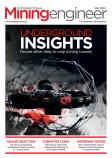A new air bearing design means more operating hours for the Sandvik RR321 premium rotary drill bit. Åke R Malm reports
The RR321, Sandvik’s latest model of premium rotary drill bits for blast hole drilling, features three air bearings with a new design to provide better load distribution. The result is longer bearing life, improved bit meters and reduced drilling costs. This means increased run time on the rig as well as more holes between bit changes.
The drill bits are used on drill rigs such as the Sandvik DS90KS blast hole drill rig in Barrick’s Pascua Lama open pit mine in Chile.
The new design extends the drill bit’s service life by an average of 10 to 15 per cent beyond what its predecessor the RR320 could achieve. In fact, test results indicate that the increase could be as high as 50 per cent in some cases.
"We managed to find a new and better configuration of the air bearings for our RR321 drill bit range,” says Petter Nilsen, Sandvik product support and sales manager, Europe. “It is quite an accomplishment to get this type of improvement on a product like the cemented carbide insert bit, which has already been honed for 50 years,” Nilsen says.
The rotary drilling method has been around for a century, but the technology took a leap 50 years ago with the introduction of carbide inserts in the drill bit cones. The carbide inserts make the bits more durable, and today a whole range of insert designs are available to cover all operating conditions. The challenge is to balance their durability with that of the air bearings.
Sandvik saw that the performance of its premium air bearing drill bits needed improvement. This is easier said than done on such a mature product, so the company decided to devote a substantial amount of research and development resources to the project. The initial phase included finite element analysis, followed by laboratory prototype tests. Then the viability of the concept was verified in field tests over a two-year period. The final result was an air bearing range with more operating hours.
For those who want even better performance, Sandvik offers the RR440 ultra-premium rotary drill bit range, which has already proved its worth for more than a decade. It features a set of grease-filled journal bearings with a dual seal to keep abrasive cuttings out. With the right combination of inserts, these bits will normally give at least twice the operating life compared with a rotary drill bit with air bearings.
Even though the ultra-premium RR440 has been on the market for some time now, the premium RR321 series is still the predominant choice. However, a growing focus on drill rig availability and productivity is causing a noticeable shift in market preference in favour of RR440. Longer operating life means fewer bit changes, which gives more drilling time per shift.
“The market is gradually moving towards drill bits with sealed journal bearings,” Nilsen says. “During the last few years we have seen a very good development for the RR440.”
The third member of Sandvik’s family of rotary drill bits is the standard model RR220. Compared with the other two, this bit has fewer features, but that doesn’t mean it has low performance. The RR220 product range was developed for price-focused customers, but it benefits from many of the developments of the RR320 and RR321 range.
Blast hole drilling
Rotary drill bits are mainly used for blast hole drilling in open pit mines. The original design can be traced back to the beginning of the 20th century. They have three legs, each with a bearing-mounted cone and pressed inserts. When a drill rig rotates a drill bit under pressure via a drill pipe, the cones will roll in a circular pattern on the rock surface. The carbide inserts on the cones then crush the rock, and the cuttings are flushed up from the hole by compressed air.
The rotary drill bit is a system of integrated components, each with its specific challenges in terms of design and materials. It is also a disposable article, so the longer it lasts the lower the drilling costs will be. At the same time, productivity will improve because of reduced downtime for bit changes.
Performance in the air
After an initial analysis, using the finite element method and subsequent prototype tests in a laboratory environment, Sandvik developed a new air bearing design. Field tests over a period of two years showed that it extended the operating life by an average of 10 to 15 per cent. In some cases the improvement could be as much as 50 per cent.
The secret to success is a different configuration of the bearing elements, which gives a better load distribution. As a result of this successful product development, the RR321 is now a new member of Sandvik’s family of rotary air bearing bits.
On site results
The performance of Sandvik’s RR321 premium air bearing bits has been tested in several types of mines. Here are two examples.
Mine type Iron ore Coal
Bit size 311mm (12¼”) 229mm (9”)
Bit type S60 S07
Standard bit distance/
service life 2,978m (9,773ft)/64h 5,434m (17,828ft)/47h
RR321 test bit distance/
service life 4,163m (13,658ft)/84h 6,284 m (20,616 ft)/56 h
Distance increase 39% 16%





















